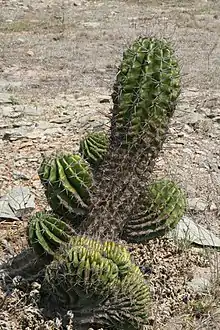Acanthocalycium rhodotrichum
Acanthocalycium rhodotrichum is a species of Acanthocalycium found in Argentina, Bolivia, Brazil, Paraguay, and Uruguay [2]
| Acanthocalycium rhodotrichum | |
|---|---|
 | |
| Scientific classification | |
| Kingdom: | Plantae |
| Clade: | Tracheophytes |
| Clade: | Angiosperms |
| Clade: | Eudicots |
| Order: | Caryophyllales |
| Family: | Cactaceae |
| Subfamily: | Cactoideae |
| Genus: | Acanthocalycium |
| Species: | A. rhodotrichum |
| Binomial name | |
| Acanthocalycium rhodotrichum (K.Schum.) Schlumpb. 2012 | |
| Synonyms | |
|
List
| |
Description
Acanthocalycium rhodotrichum usually grows in groups with erect or ascending, cylindrical, dull green shoots that reach heights of 30 to 80 centimeters with a diameter of up to 12 centimeters. There are eight to 18 low ribs that are somewhat wavy. The areoles on it are 1.5 to 2.5 centimeters apart. Yellowish thorns with a brown tip emerge from them. The single central spine, which can also be absent, is bent slightly upwards and is up to 2 centimeters long. The spread and slightly curved four to eight radial spines are up to 2 centimeters long.
The funnel-shaped white flowers open at night. They grow up to 15 centimeters long.[3]
Distribution
Acanthocalycium rhodotrichum is widespread in the Brazilian state of Mato Grosso do Sul, in Paraguay and in northeast Argentina at altitudes of up to 500 meters.[4]
Subspecies
Recognized subspecies:[2]
| Image | Subspecies | Description | Distribution |
|---|---|---|---|
 | Acanthocalycium rhodotrichum subsp. chacoanum (Schütz) Schlumpb. | Has twelve to 18 ribs and seven to eight marginal spines. The first description as Echinopsis chacoana by Bohumil Schütz was published in 1949. Boris O. Schlumpberger introduced the species as a subspecies to Acanthocalycium rhodotrichum in 2021.[5] | Common in the Chaco vegetation in Paraguay. |
 | Acanthocalycium rhodotrichum subsp. rhodotrichum | Distributed deep in the Chaco vegetation in Paraguay and the Argentine provinces of Chaco, Formosa, Corrientes, Entre Ríos, Santiago del Estero and Santa Fe. | |
Taxonomy
The first description as Echinopsis rhodotricha by Karl Moritz Schumann was published in 1900. Boris O. Schlumpberger placed the species in the genus Acanthocalycium in 2012.
References
- "The IUCN Red List of Threatened Species". IUCN Red List of Threatened Species. 2010-09-20. Retrieved 2023-09-17.
- "Acanthocalycium rhodotrichum (K.Schum.) Schlumpb. - Plants of the World Online". Plants of the World Online. Retrieved 2022-11-17.
- Anderson, Edward F.; Eggli, Urs; Anderson, Edward F. (2005). Das große Kakteen-Lexikon (in German). Stuttgart (Hohenheim): Ulmer. p. 241. ISBN 3-8001-4573-1.
- "Monatsschrift für Kakteenkunde". J. Neumann. 1900. Retrieved 2023-09-17.
- Korotkova, Nadja; Aquino, David; Arias, Salvador; Eggli, Urs; Franck, Alan; Gómez-Hinostrosa, Carlos; Guerrero, Pablo C.; Hernández, Héctor M.; Kohlbecker, Andreas; Köhler, Matias; Luther, Katja; Majure, Lucas C.; Müller, Andreas; Metzing, Detlev; Nyffeler, Reto; Sánchez, Daniel; Schlumpberger, Boris; Berendsohn, Walter G. (2021-08-31). "Cactaceae at Caryophyllales.org – a dynamic online species-level taxonomic backbone for the family". Willdenowia. Botanic Garden and Botanical Museum Berlin, Freie Universitaet Berlin. 51 (2). doi:10.3372/wi.51.51208. ISSN 0511-9618.
External links
 Media related to Acanthocalycium rhodotrichum at Wikimedia Commons
Media related to Acanthocalycium rhodotrichum at Wikimedia Commons Data related to Acanthocalycium rhodotrichum at Wikispecies
Data related to Acanthocalycium rhodotrichum at Wikispecies
